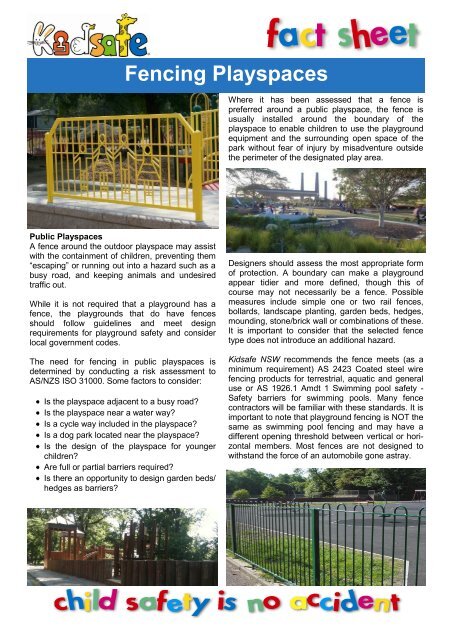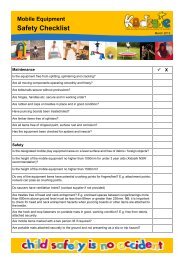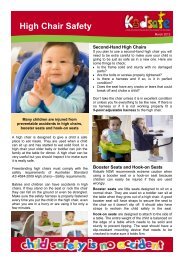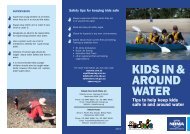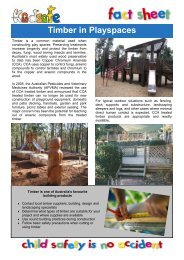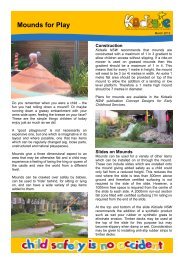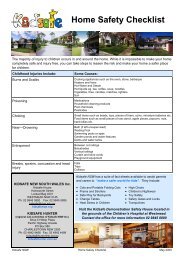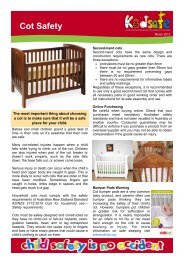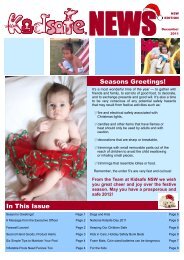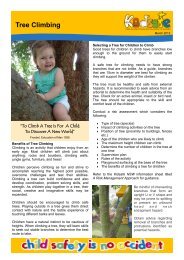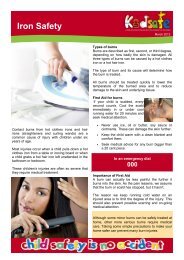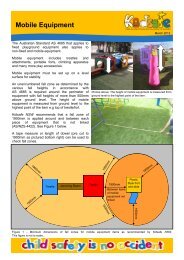Fencing Playspaces - Kidsafe NSW
Fencing Playspaces - Kidsafe NSW
Fencing Playspaces - Kidsafe NSW
You also want an ePaper? Increase the reach of your titles
YUMPU automatically turns print PDFs into web optimized ePapers that Google loves.
<strong>Fencing</strong> <strong>Playspaces</strong><br />
Where it has been assessed that a fence is<br />
preferred around a public playspace, the fence is<br />
usually installed around the boundary of the<br />
playspace to enable children to use the playground<br />
equipment and the surrounding open space of the<br />
park without fear of injury by misadventure outside<br />
the perimeter of the designated play area.<br />
Public <strong>Playspaces</strong><br />
A fence around the outdoor playspace may assist<br />
with the containment of children, preventing them<br />
“escaping” or running out into a hazard such as a<br />
busy road, and keeping animals and undesired<br />
traffic out.<br />
While it is not required that a playground has a<br />
fence, the playgrounds that do have fences<br />
should follow guidelines and meet design<br />
requirements for playground safety and consider<br />
local government codes.<br />
The need for fencing in public playspaces is<br />
determined by conducting a risk assessment to<br />
AS/NZS ISO 31000. Some factors to consider:<br />
Is the playspace adjacent to a busy road?<br />
Is the playspace near a water way?<br />
Is a cycle way included in the playspace?<br />
Is a dog park located near the playspace?<br />
Is the design of the playspace for younger<br />
children?<br />
Are full or partial barriers required?<br />
Is there an opportunity to design garden beds/<br />
hedges as barriers?<br />
Designers should assess the most appropriate form<br />
of protection. A boundary can make a playground<br />
appear tidier and more defined, though this of<br />
course may not necessarily be a fence. Possible<br />
measures include simple one or two rail fences,<br />
bollards, landscape planting, garden beds, hedges,<br />
mounding, stone/brick wall or combinations of these.<br />
It is important to consider that the selected fence<br />
type does not introduce an additional hazard.<br />
<strong>Kidsafe</strong> <strong>NSW</strong> recommends the fence meets (as a<br />
minimum requirement) AS 2423 Coated steel wire<br />
fencing products for terrestrial, aquatic and general<br />
use or AS 1926.1 Amdt 1 Swimming pool safety -<br />
Safety barriers for swimming pools. Many fence<br />
contractors will be familiar with these standards. It is<br />
important to note that playground fencing is NOT the<br />
same as swimming pool fencing and may have a<br />
different opening threshold between vertical or horizontal<br />
members. Most fences are not designed to<br />
withstand the force of an automobile gone astray.
Recommended <strong>Fencing</strong> Specifications<br />
Fence Height: It is recommended that the fence be<br />
at least 1200mm – 1800mm in height.<br />
Children’s Services<br />
Minimum height requirements for fencing in<br />
children’s services is not defined in the Education<br />
and Care Services National Regulation 2011.<br />
<strong>Kidsafe</strong> <strong>NSW</strong> recommends a minimum height of<br />
1200mm for perimeter fencing, however it is best<br />
to check the Development Control Plan of your<br />
local council for requirements for fencing including<br />
minimum and maximum height, type of fence,<br />
construction material and method.<br />
Where fences are used to divide play areas or<br />
surrounding verandahs etc. the minimum height<br />
recommended is 900mm. Avoid horizontal rails<br />
less than 900mm apart as rails may provide<br />
unintended access to the top rail. To prevent<br />
unintended access to the top of the fence by<br />
children, it is recommended to place items/<br />
equipment a minimum 1000mm from the fence.<br />
Schools<br />
Many <strong>NSW</strong> schools have provided security<br />
fencing surrounding the perimeter of the school.<br />
Schools may have requirements for internal<br />
fences, mainly for playgrounds and/or sports pitch<br />
surrounds. Schools should assess for the most<br />
appropriate type of fence for these areas and<br />
consider recommended fencing specifications on<br />
this fact sheet.<br />
Fence Material: The fence can be constructed of a<br />
variety of materials such as timber, colourbond,<br />
metal bars or chain link. The chain-link versions<br />
can be covered with a polyvinyl coating that gives<br />
the chain link a softer feel. Select materials that are<br />
less likely to be climbed/scaled by children.<br />
Gates: It is recommended that playground fence<br />
gates have self-closing hinges on the gate certified<br />
to AS 2820 Gate units for private swimming pools.<br />
The latch must also automatically catch when the<br />
gate closes. Ensure that a gap of at least 12mm is<br />
present at each side when in use to avoid finger<br />
crush hazards. Monitor in ongoing maintenance<br />
inspections to ensure gates remain in sound working<br />
order.<br />
Rails: <strong>Kidsafe</strong> <strong>NSW</strong> recommends the lower<br />
horizontal rail be positioned at the bottom of the<br />
pickets or panel to reduce the likelihood of<br />
tunnelling under the fence and preventing<br />
unintended access to the top horizontal rail. Avoid<br />
a mid horizontal rail where possible.<br />
Top rail profile: A flat top rail is recommended.<br />
Loop top or rod top may potentially create a<br />
hanging point for a child’s head between the<br />
pickets protruding above the top rail. For existing<br />
fences with protruding loops or rods at the top,<br />
ensure that climbing access is not provided for<br />
children to the top of the fence.<br />
KIDSAFE NEW SOUTH WALES Inc.<br />
Playground Advisory Unit<br />
<strong>Kidsafe</strong> House<br />
Hainsworth Street<br />
Locked Bag 4001<br />
WESTMEAD <strong>NSW</strong> 2145<br />
Ph: 02 9845 0890 Fax: 02 9845 0895<br />
kidsafe@chw.edu.au<br />
kidsafensw.org<br />
February 2012


